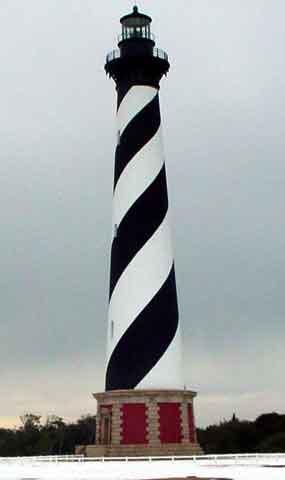Lighthouses are a popular attraction, and what better time to appreciate one than at night? Cape Hatteras National Seashore is offering the unusual opportunity to climb to the top of the venerable Cape Hatteras Lighthouse on a new nighttime tour.
These special tours will be offered on Thursday evenings only, beginning on May 28 and ending on Sept 3, 2009. The tours will be conducted on those evenings at 8 p.m. and 9 p.m. Due to the limited space inside the structure, each program will be limited to 15 people.
Tickets can be purchased on-site, on the day of the tour only, between 8:15 a.m. and 5:30 p.m. and are nonrefundable. Important information about ticket costs and procedures for both the nighttime tour and the regular daily climbing tours is available on the park website.
Participants need to bring their own flashlights for illumination during the climb. This is a great chance to observe the lighthouse beacon in operation from an unusual perspective.
The current Cape Hatteras Lighthouse, completed in 1870, is the tallest brick lighthouse in North America.
It protects one of the most hazardous sections of the Atlantic Coast. Offshore of Cape Hatteras, the Gulf Stream collides with the Virginia Drift, a branch of the Labrador Current from Canada. This current forces southbound ships into a dangerous twelve-mile long sandbar called Diamond Shoals. Hundreds and possibly thousands of shipwrecks in this area have given it the reputation as the “Graveyard of the Atlantic”.
The lighthouse will continue to be open for climbing daily from 9 a.m. to 4:30 p.m. daily through Columbus Day, Monday, October 12, 2009. From June 7, 2009 through Labor Day, the climbing hours will be expanded to 9 a.m. to 5:30 p.m. See the park website for ticket information and other details.
A climb to the top of the Cape Hatteras Light is a unique experience, but the park does offer some important cautions:
The climb is strenuous! The 248 iron spiral stairs to the top equal climbing a 12 story building. The stairs have a handrail only on one side and a landing every 31 steps. There is no air conditioning. It may be noisy, humid, hot and dim inside the lighthouse and there is two-way traffic on the narrow stairs.
Visitors with heart, respiratory or other medical conditions, or who have trouble climbing stairs, should use their own discretion as to whether to climb the tower.
There are some common-sense safety rules for climbing the lighthouse:
• Children must be at least 42” tall and capable of climbing all steps on their own.
• Children under 12 must be escorted by an adult.
• No person may be lifted or carried.
• Running, jumping, or stomping on stairs and landings is prohibited.
• Do not eat, drink, smoke or chew tobacco.
• No pets, other than service animals.
• Do not arrive in heels over 1 ½ inches high or in bare feet.
• Leave umbrellas in your car.
• Backpacks, tripods, coolers, beach bags, surfboards, fishing poles, etc. also need to be left in your car.
The park website includes driving directions and maps to help you plan a visit.




Add comment